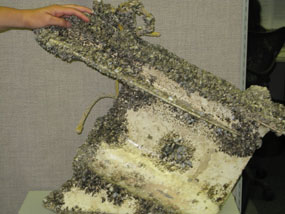Adaptation
Zebra Mussels are motile. They use their muscular foot to move about in their environment, including pipes, rocks, and many other structures. They use the muscular foot to move into estuaries and river mouths where they use their adaptation of excretory organs to battle the flow of water by using endosmosis endosmosis.
Zebra Mussels can also disperse during all life
stages that enables them to rapidly spread. Veligers (the larva
stage) invade downstream, and adults usually attach to boat
hulls and floating objects. Both of these methods enable the
Zebra Mussels to transport to new locations. Another beneficial
adaptation of the Zebra Mussel is that
there are not any native
mussels that have byssal adult stage.
The Zebra Mussel has many advantages over the native species
that allows them to dominate. They also use this byssus to
attach to any hard surface. This trait is also common with many
saltwater mussels, but not freshwater mussels. Zebra Mussels
also do not require a host in order to complete their life
cycle. This gives them another advantage over the native
mussels. However, Zebra Mussels do have poor physiological
resistance. They depend solely on rapid growth and fecundity for
population recovery. The native North American mussels have an
advantage over the invasive Zebra Mussel since they are able to
adapt to stable environments where there is a small amount of
disturbance and in turn developed resistance to environmental
extremes. Check out the habitat page
to see where they live!
The Zebra Mussels great filtering system can affect many surrounding species, such as freshwater fish. This can include species ranging from the fathead minnow, pumpkin seed fish, freshwater drum, and many others.
